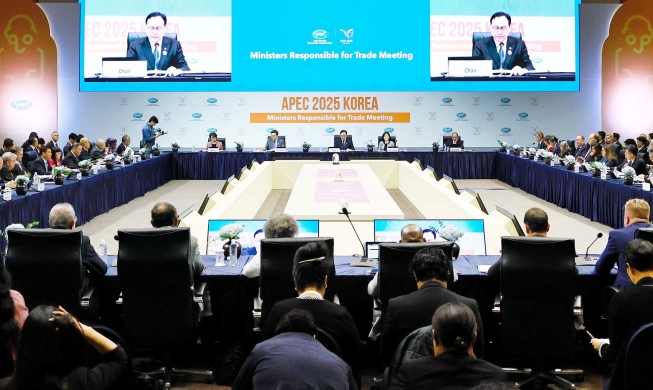View this article in another language
- 한국어
- English
- 日本語
- 中文
- العربية
- Español
- Français
- Deutsch
- Pусский
- Tiếng Việt
- Indonesian
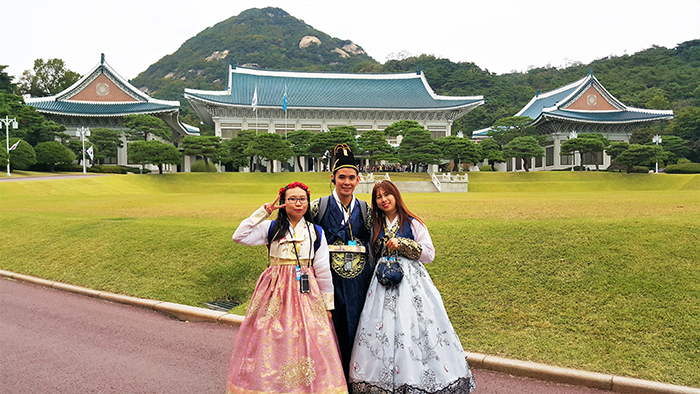
Korea.net Honorary Reporter Lalien Guillen Park (left) poses for a photo with her friends during a tour at Cheong Wa Dae.
By Korea.net Honorary Reporter Lalien Guillen Park from the Philippines
Photos = Lalien Guillen Park
It has always been a dream of mine to visit Cheong Wa Dae, the official residence and workplace of the president of South Korea. Cheong Wa Dae literally means the “Pavilion of Blue Tiles,” the obvious reason behind its other English name, the Blue House.
That was why when two of my friends came to visit Korea last October, I eagerly suggested we do a Cheong Wa Dae tour. Let me share with you our quick, yet memorable, journey to the Pavilion of Blue Tiles.
Preparation
Five months prior to our desired date to visit Cheong Wa Dae, we made a reservation at its official website. To make a reservation, our passport details were required. We made sure to fill in the application with the correct details shown in our passports. A confirmation letter was sent via e-mail after the reservation was made. The email also came with some instructions and an overview of the tour. We had to print out the confirmation letter before the tour because they would be asked for it along with our passports on the day of the tour.
The Tour
Meeting Place: Parking Lot at the East Gate of Gyeongbokgung Palace
We were instructed to be at the meeting place 30 minutes before our reserved time. We presented our passports along with the printed confirmation letter. They were quite meticulous in checking our passport details, but they were also very friendly. Our guide, who was a Cheong Wa Dae security officer, led us onboard a huge tour bus, but it turned out that there were only four of us on the tour. It was quite funny how big the tour bus was, but, in fact, there was only a total of six people inside, including the driver and our guide. Our guide cordially joked that they especially reserved an entire tour bus just for us because we were VIPs. We had a good laugh as he said that.
Security Check and Orientation

After the security check, visitors are given their passes.
It was a quick ride from Gyeongbokgung Palace to Cheong Wa Dae. When we arrived, we saw other groups of local tourists queuing for a security check. The security check was very strict. Our bags and possessions went through the X-ray machines. When they saw my bottle with water in it, they asked me to drink some of it in front of them. Strict as they might be, we didn’t have any complaints. We fully understood the sensitivity of the security issues around Cheong Wa Dae. After all, it's the very place where the highest authority in the entire country stands.
After the security check, we were given our visitor passes and we headed to a room for an orientation session. An officer in a white uniform welcomed us and conducted the brief orientation. The tour was solely in Korean. We didn’t understand much about the orientation, but we were each given audio guides in English.
After the orientation, the tour started. It was a little rainy that day and they gave us plastic raincoats and very cute souvenirs, card holders. We truly appreciated the warm welcome.
The Chunchugwan Press Center
The first stop was the Chunchugwan Press Center. It can accommodate about 300 journalists at the same time. We were not allowed to take any pictures there.
The Nokjiwon Garden
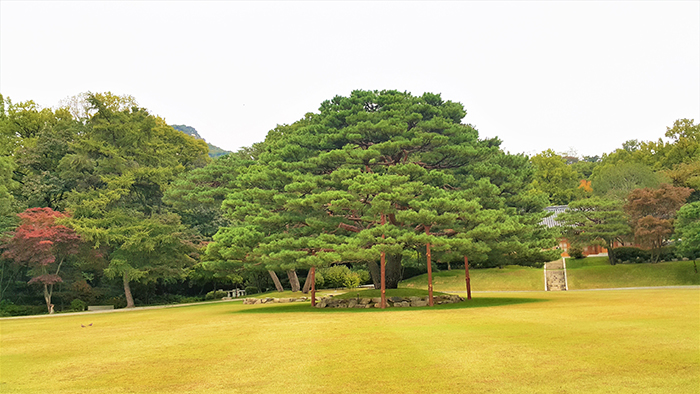
A 160-year-old pine tree is preserved in the Nokjiwon garden at Cheong Wa Dae.
This garden is where presidents plant commemorative trees. It's a beautiful garden with some 120 different species of trees. In the middle of the Nokjiwon, there's a 17-meter pine tree that's more than 160-years-old.
Seeing it, we couldn’t help but feel amazed. Luckily, we were able to take pictures in the Nokjiwon. Once we got the signal, everyone was busy clicking with their cameras.
All of the security personnel who were there throughout the tour also offered to take pictures of the tourists. There was a sudden change of mood in the air. Everyone became comfortable and enjoyed taking pictures.
The Gyeongmoodae
Here was the former Cheong Wa Dae main building.
The Yeomingwan
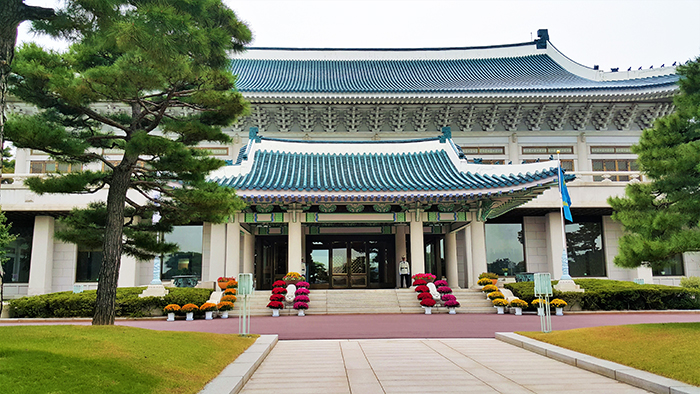
The Yeomingwan is where the president works.
The highlight of our Cheong Wa Dae tour was the Yeomingwan. This is where the president works, the cabinet meetings are held, and where major decisions about running the entire country are made. How cool was that? I've only seen this place in the news, and I was really overwhelmed to see it with my own eyes.
Of course, we weren't allowed to enter, but I was happy just to be able to take pictures of it.
The Yeongbingwan State Guest House
Otherwise known as the State Guest House, this is where official events with non-Korean guests are held, or sometimes it's used to hold large official meetings.
The Chilgung
The last part of our tour is the Chilgung burial site. This is where the ancestral tablets of seven royal concubines are enshrined. We enjoyed the architecture of the place. Our imagination was tickled as to how the royal concubines lived back then.
Have we now walked along the paths that they’ve walked, too? Was it easy or difficult for them to live as royal concubines? Our questions might never be answered, but one thing was definite that day. The Chilgung burial site connected the past and the present for us, in that very moment. For that, we were grateful.
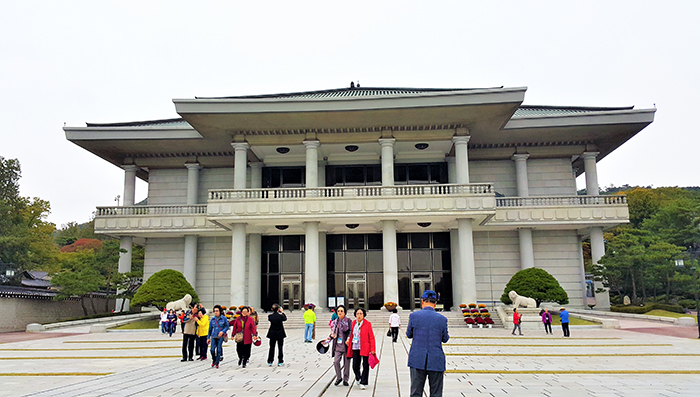
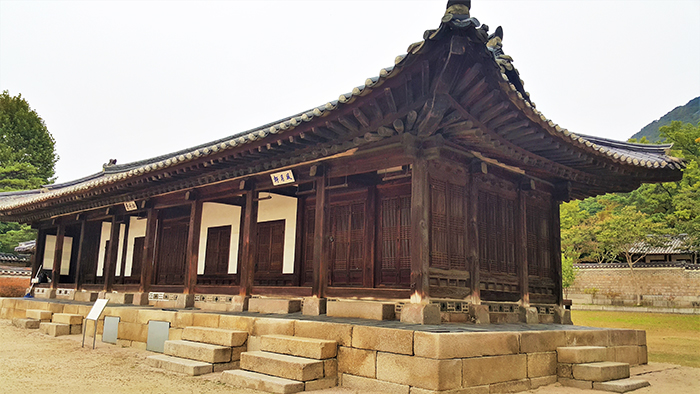
The Yeongbingwan (top) and the Chilgung (bottom) are both part of the Cheong Wa Dae tour.
End of Tour
We returned our audio guides before boarding the shuttle bus that would take us back to Gyeongbokgung Palace. The entire tour lasted for an hour, or maybe a bit more. It was quick, but it was a very memorable one hour. We felt somehow special to be able to enter the area of the seat of Korean government. We were able to see a pine tree that was more than a 160-years-old. Going on a tour under the very tight security was a first for us, and we considered that to be a new and unique experience. At the end of the tour, we took with us some good memories and a great experience that the three of us will cherish for a long, long time.
wisdom117@korea.kr
* This article is written by a Korea.net Honorary Reporter. Our group of Honorary Reporters are from all around the world, and they share with Korea.net their love and passion for all things Korean.
